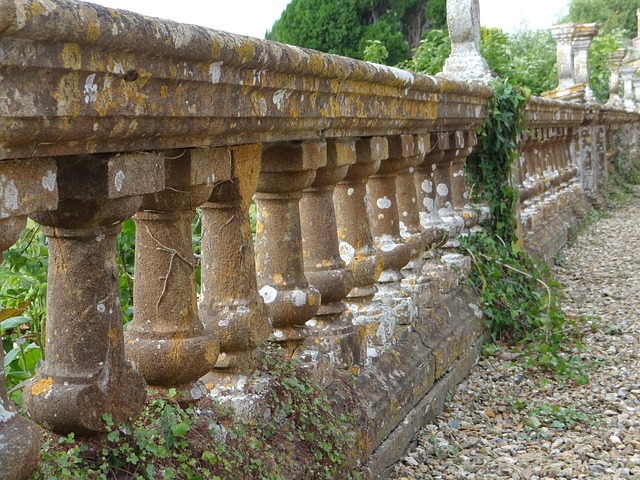Railings
Contents |
[edit] Introduction
Railings are used on stairs, balconies, galleries, decks, ramps, walkways and so on as a means of providing separation, support and safety.
Railings can be made from a very wide range of materials:
- Wrought or cast iron.
- Stainless steel.
- Timber.
- Plastic.
[edit] Balustrade
Railings differ from balusters which are made of stone, wood or metal, which are usually rounded or vase-shaped and support a rail or coping in a balustrade. They are common in classical forms of architecture. The balusters of a stairway together with handrail is known by the term banister.
A survey carried out by stair part specialist Jackson Woodturners revealed that only 15% of the public know the correct name for a balustrade.
NB See SCOSS Alert Dec 2019, Glass balustrades may pose a serious risk to safety.
[edit] Guard rails
Guard rails tend to be a restrictive form of railing, and aim to create the protective limitation of a boundary as opposed to handrails which aim to provide support. Many public spaces are fitted with guardrails as a means of preventing access and maintaining safety.
The Work at Height Regulations 2005 require that, for construction work, railings must have a minimum height of 950 mm and any gap between top and any intermediate rail should not exceed 470 mm.
Approved Document K of the Building Regulations requires that in a building that may be used by young children:
- The spaces between railings should be close enough together to prevent a 100 mm sphere from passing through.
- Horizontal rails should be avoided to prevent climbing.
See also Guarding.
[edit] Handrails
Approved document K defines a handrail as ’..a rail, at hand height or a little higher, for people to hold for support.’This can be useful for example when ascending or descending stairs or ramps.
Approved Document K requires that:
- The top of the handrail should be positioned 900-1000 mm from the pitch line or floor.
- The handrail may form the top of a guarding as long as the heights are matched.
- A handrail should be provided on both sides of stairs that are 1 m wide or wider.
- If stairs are more than 2m wide, then they should be divided into flights of no less than 1,000mm.
- Handrails should be 50-75 mm away from the wall to which they are attached.
- Circular handrails should be 32-50 mm in diameter.
- Non-circular handrails should be 50 mm wide and 39 mm deep, usually with rounded edges.
In addition to this, for buildings other than dwellings:
- Where there is a full guarding, and a second (lower) handrail, it should be 600 mm above the pitch line of the steps of ramp surface.
- Handrails should not project into an access route.
- Handrails should contrast visually without being highly reflective.
- Handrails should be slip-resistant and not liable to become too hot or cold to the touch.
- Handrails should continue, at least 300mm beyond the top and bottom of the stairs and should be finished in a way that reduces the risk of clothing being caught.
In dwellings and common access areas in buildings that contain flats:
- Handrails on one or both sides should be provided for ramps less than 1 m wide.
- Ramps wider than 1 m should have handrails on both sides.
- Handrails are not needed for ramps 600 mm or less in height.
- Handrails should be positioned 900-1000 mm above the surface of the ramp.
NB According to Approved Document K, Protection from falling, collision and impact, 'guarding' is ‘…a barrier that denies pedestrians or vehicles access to another area, for example the floor below’.
[edit] Related articles on Designing Buildings
Featured articles and news
The UK's Modern Industrial Strategy: A 10 year plan
Previous consultation criticism, current key elements and general support with some persisting reservations.
Building Safety Regulator reforms
New roles, new staff and a new fast track service pave the way for a single construction regulator.
Architectural Technologist CPDs and Communications
CIAT CPD… and how you can do it!
Cooling centres and cool spaces
Managing extreme heat in cities by directing the public to places for heat stress relief and water sources.
Winter gardens: A brief history and warm variations
Extending the season with glass in different forms and terms.
Restoring Great Yarmouth's Winter Gardens
Transforming one of the least sustainable constructions imaginable.
Construction Skills Mission Board launch sector drive
Newly formed government and industry collaboration set strategy for recruiting an additional 100,000 construction workers a year.
New Architects Code comes into effect in September 2025
ARB Architects Code of Conduct and Practice available with ongoing consultation regarding guidance.
Welsh Skills Body (Medr) launches ambitious plan
The new skills body brings together funding and regulation of tertiary education and research for the devolved nation.
Paul Gandy FCIOB announced as next CIOB President
Former Tilbury Douglas CEO takes helm.
UK Infrastructure: A 10 Year Strategy. In brief with reactions
With the National Infrastructure and Service Transformation Authority (NISTA).
Ebenezer Howard: inventor of the garden city. Book review.
The Grenfell Tower fire, eight years on
A time to pause and reflect as Dubai tower block fire reported just before anniversary.
Airtightness Topic Guide BSRIA TG 27/2025
Explaining the basics of airtightness, what it is, why it's important, when it's required and how it's carried out.
Construction contract awards hit lowest point of 2025
Plummeting for second consecutive month, intensifying concerns for housing and infrastructure goals.
Understanding Mental Health in the Built Environment 2025
Examining the state of mental health in construction, shedding light on levels of stress, anxiety and depression.
The benefits of engaging with insulation manufacturers
When considering ground floor constructions.
Lighting Industry endorses Blueprint for Electrification
The Lighting Industry Association fully supports the ECA Blueprint as a timely, urgent call to action.

























